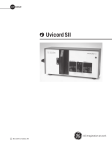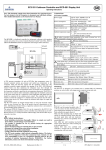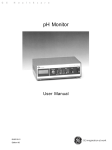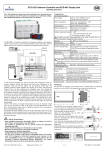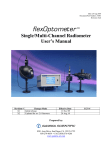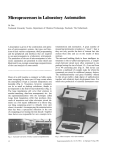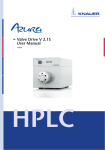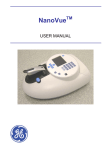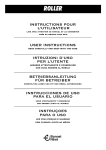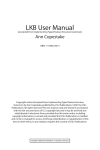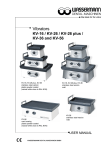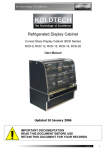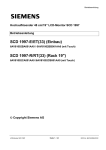Download マニュアル Monitor UV-1
Transcript
Monitor UV-1 User Manual 59-7797-01 Edition AG Important user information Reading this entire manual is recommended for full understanding and use of this product. ● The exclamation mark within an equilateral triangle is intended to alert the user to the presence of important operating and maintenance instructions in the literature accompanying the instrument. Should You have any comments on this manual, we will be pleased to receive them at: GE Healthcare Bio-Sciences AB S-75182 Uppsala Sweden Warranty and Liability GE Healthcare Bio-Sciences AB guarantees that the product delivered has been thoroughly tested to ensure that it meets its published specifications. The warranty included in the conditions of delivery is valid only if the product has been installed and used according to the instructions supplied by GE Healthcare Bio-Sciences AB. GE Healthcare Bio-Sciences AB shall in no event be liable for incidental or consequential damages, including without limitation, lost profits, loss of income, loss of business opportunities, loss of use and other related exposures, however caused, arising from the faulty and incorrect use of the product. Trade marks FPLC ® is the exclusive trade mark of GE Healthcare Bio-Sciences AB. In view of the risk of trade mark degeneration, it is respectfully suggested that authours wishing to use this designation refer to its trade mark status at least once in each article. Copyright © 1995 GE Healthcare Bio-Sciences AB GE Healthcare Bio-Sciences AB reserves the right to make changes in the specifications without prior All rights reserved. No part of this publication notice. may be reproduced, stored in a retrieval system or transmitted in any form by any means, without permission in written form from the company. Contents 1. 2. 3. 4. 5. 6. 7. 8. Introduction ........................................................................................ 4 General Description .......................................................................... 5 2.1 Basic principle ............................................................................. 5 2.2 Optical unit ................................................................................. 7 2.3 Control unit ................................................................................. 9 Installation ........................................................................................ 11 3.1 Site requirements ...................................................................... 11 3.2 Unpacking ................................................................................. 11 3.3 Electrical connections .............................................................. 11 3.4 Installation of the filter ............................................................ 12 3.5 Installation of the flow cell ..................................................... 13 3.6 Connecting the optical unit .................................................... 14 3.7 Connecting a recorder ............................................................. 14 Operation .......................................................................................... 15 4.1 Choice of wavelength .............................................................. 15 4.2 Choice of AU or transmission (%T) ....................................... 15 4.3 Conversion table T% to AU and OD ..................................... 16 4.4 Start-up ...................................................................................... 16 4.5 Stabilization time...................................................................... 16 4.6 Basic operating procedure - AU ............................................. 17 4.7 Basic operating procedure - Transmission (%T) .................. 17 4.8 Shut down ................................................................................. 17 Maintenance ..................................................................................... 18 5.1 General precautions ................................................................. 18 5.2 Cleaning the flow cell .............................................................. 18 5.3 Changing the flow cell ............................................................ 19 5.4 Interference filters .................................................................... 20 5.5 Other optical surfaces .............................................................. 20 5.6 Instrument housing ................................................................. 20 5.7 Lamp and optical system test ................................................. 20 5.8 Changing the mercury lamp................................................... 21 5.9 Mercury lamp - maximum light adjustment ........................ 22 Trouble-shooting .............................................................................. 23 Technical Specifications .................................................................. 24 Accessories and Spare Parts ........................................................... 25 3 1. Introduction 1. Introduction The UV-1 is a fixed wavelength UV monitor, consisting of a control unit and an optical unit that can be positioned up to 10 meters apart. A mercury lamp is the stable light source, furthermore a built-in reference cell eliminates baseline drift. The output signal can be recorded in either AU or %T. Sensitivity range between 0.01 and 2 AUFS, or (0-100%T). The UV-1 offers a range of three detection wavelengths: 254, 280 and 405 nm. In addition, five flow cells are available for different applications in Standard Chromatography, FPLC and Industrial applications. 4 2. General Description 2. General Description 2.1 Basic principle GE Healthcare LKB Monitor UV-1 consists of an optical unit containing the flow cell, lamp, filter assemblies and preamplifiers, and a control unit containing the signal processing circuits. The two units are connected via a multi-core cable hardwired from the control unit to the optical unit. Connection to the recorder and the mains supply is made via the control unit. The single path Monitor UV-1 is a dual beam instrument with a sample cell and a reference cell. Optical path lengths are 10 mm, 3 mm, or 2 mm depending upon the flow cell chosen. Note: Flow cell S-2 has only the sample cell. The sample cell and reference cell are angled to receive light from the same point in the lamp (Fig. 1) thus assuring a stable base-line by negating the effects of variations in lamp intensity. The lamp is powered by a stabilized DC to AC converter operating at 20 kHz to maximize its efficiency. Lamp output is independent of variations in the line voltage. Light from the lamp passes through an aperture (254 nm, 405 nm) or a fluorescence converter (280 nm) and through the reference cell and sample cell. The light output from each cell passes through an interference filter and falls onto a solid state photo-detector whose output is a linear function of the light intensity (Fig. 1 and Fig. 2). Fig. 1. Optical path. 5 2. General Description Fig. 2 Block diagram The photocurrent from each detector is amplified in a pre-amplifier before passing to the signal processing circuitry in the control unit. If transmission is to be monitored, the signal passes directly to the low pass filter. If AU is to be monitored, the reference cell light intensity (IR) is compared with the sample cell intensity (IS) to form log (IR/IS) in a logarithmic circuit before passing to the low-pass filter. The signal finally passes to the range selector before being presented to the output terminal. 6 2. General Description 2.2 Optical unit Front panel controls 5 4 1 2 3 Fig. 3. Optical unit. Front panel. No. Item Description 1 Cell holder The complete cell holder is removed by turning the locking (Fig. 4:6) knob on the rear panel 2 Sample inlet Inlet for sample flow 3 Sample outlet Outlet for sample flow 4 Reference inlet Inlet for flowing reference liquid. The reference cell may be operated dry, with static reference liquid 5 Reference outlet Outlet for flowing reference liquid 7 2. General Description Rear panel controls 6 11 9 Guide pin Screw 7 10 8 Fig. 4. Optical unit. Rear panel. No. Item Description 6 Locking knob The cell holder is in locked position when the locking knob is turned fully in the direction of the arrow 7 Filter inlet 8 Converter or Filters, converters or apertures are inserted in the positions indicated. When inserting them, align the arrowhead on the end of the filter or converter Aperturewith the arrowhead next to the appropriate opening. Filters, converters and apertures must be pressed fully 9 Support rod Enables the optical unit to be mounted on laboratory scaffolding. The rod may be secured in either of two positions by a screw and a guide-pin 10 Support rod Alternative position for support rod 11 Multi-core cable Connects the optical unit to the control unit via an 11-pin plug with a snap-lock. For disconnection squeeze the ribbed sides of the plug firmly and pull Warning: 8 The optical unit contains a UV-source which is exposed if the cover is removed. 2. General Description 2.3 Control unit Front panel controls 15 12 16 13 14 Fig. 5. Control unit. Front panel. No. Item Description 12 Absorbance range selector Selector for the desired absorbance range 0.01, 0.02, 0.05, 0.1, 0.2, 0.5, 1 or 2 AU full scale deflection. In the position SHORT, the signal output terminals are disconnected from the rest of the control circuitry and short-circuited. This position is useful when setting zero on the recorder. 13 Mode switch AU or %T The AU / % T switch, enables the UV-1 to be used to monitor the absorbance or transmission of a flowing liquid. When the UV-1 is used in the AU mode, each of the other position corresponds to the optical absorbance which will give a full scale deflection (fsd) on a recorder with a sensitivity of 10 mV. Absorbances are measured relative to air or a liquid which is present in the reference cell When the recorder is used together with UV-1 in the % T mode, the absorbance range selector switch is used, together with baseline adjust, to adjust the recorder response corresponding to 100 % T 14 Baseline adjust Ten-turn potentiometer to adjust the recorder baseline 15 Indicator lamp Indicates power is on 16 Mains switch The UV-1 is turned on by switching this knob in the ON (upper) position. The indicator lamp will light to show that the mains voltage is on 9 2. General Description Rear panel controls Fig. 6. Control unit. Rear panel. No. Item Description 17 Mains voltage selector Selects mains voltage 110, 130, 220 and 240 V 18 Fuse holder Mains fuses: 19 Signal outputs The output signal is a 10 mV DC signal. The terminals are connected to a potentiometric recorder via shielded cables supplied. The UV-1 is normally earthed via the mains ground 20 Mains inlet Inlet for the mains cable 21 Optical unit inlet Inlet for the optical unit 22 Ground terminal To connect the shield of an output signal cable Note: 10 1 x 250 mA for 110-130 V 60 Hz 1 x 125 mA for 220-240 V 50 Hz Do not attempt to ground the control unit via the recorder ground as the UV-1 is grounded via the mains ground. 3. Installation 3. Installation 3.1 Site requirements UV-1 should be installed on a stable, flat surface away from all sources of vibration. The atmosphere should be free of both excess humidity and corrosive or contaminated vapours which may form deposits on the component in the optical path. UV-1 can be installed either in a coldroom or at ambient temperature in the laboratory. To minimise drift, the temperature should be kept constant. UV-1 optical unit should be positioned away from all sources of draught, heat and direct sunlight. UV-1 should be placed away from any compressor and the fan stream from coldboxes and coldrooms. The UV-1 may be operated ambient temperatures in the range 0-40 °C (20-30 °C at full specifications). One mains power point is required to operate UV-1. Separate power points are required for all ancillary equipment, such as recorder. The power consumption of the monitor is max 20 VA. 3.2 Unpacking Note: It is important that the interference filters and flow cells should not be handled during unpacking. For protection of these items they should remain in their packing materials until required for use. Carefully unpack the UV-1. Check the contents against the packing list supplied. Inspect for any damage that may have occurred during transit. Report any damage immediately to the local GE Healthcare representative and to the transport company concerned. Save the packing material if future transport can be foreseen. 3.3 Electrical connections The instrument is supplied with mains cables and fuses for both 100-130 V and 220-240 V operation. 1. Ensure that the mains switch (Fig. 5:16) on the front panel of the control unit is in the OFF position. 2. Select the correct value of fuse from the fuse kits supplied. For 110-130 V operation, use the 250 mA fuse supplied. For 220-240 V operation, use the 125 mA fuse supplied. Insert the fuse into the fuse cap, and then fit the fuse cap into the fuse holder on the rear panel (Fig. 6:18) of the instrument. 3. Check that the mains voltage selector (Fig. 6:17) on the rear panel of the control unit is set to the mains voltage in the laboratory. If necessary, turn with a thick bladed screwdriver the mains voltage setting until appropriate setting is indicated in the small window. Note: Use the 220 V setting for a 230 V mains outlet. 11 3. Installation Mains voltage Voltage selector setting Fuse 110 V 130 V 220-230 V 240 V 110 130 220 240 250 mA 250 mA 125 mA 125 mA 4. 3.4 Installation of the filter Select the mains cable corresponding to your mains outlet. Discard unwanted mains cable immediately. Connect the instrument to a grounded mains outlet. Note: Do NOT switch on. Note: Special care must be taken when handling interference filters. DO NOT touch the filter surface. The filters should not allowed to come in contact with any liquid or exposed to temperatures above 60 °C. For directions on cleaning interference filters, see Section 5.4 1. Select the appropriate filter for the wavelength to be used. 2. Insert the filter and converter or aperture in the optical unit (Fig. 4:7, Fig. 4:8). Each filter is marked with its wavelength and the letter F. The 280 nm converter is marked 280 C. The aperture for use with the 254 nm or 405 nm filters is marked 0. The filter and converter or aperture must be pushed fully home. 12 Wavelength Filter Converter or Aperture 254 nm 280 nm 405 nm 254 F 280 F 405 F 0 280 C 0 3. Installation 3.5 Installation of the flow cell Monitor UV-1 accepts flow cells for Standard Chromatography, FPLC and industrial applications. Product Code No. Material of wetted parts Path length Total dead volume Illuminated Pressure volume limit Application area S-2 19-4840-02 Fluoro-plastic, optical quartz 2 mm 80 µl 2 µl 0.3 MPa (3 bar) Standard Chromatography HR-10 19-6254-02 Fluoro-plastic, optical quartz,titanium 10 mm 24 µl 8.7 µl 1.0 Mpa (10 bar) FPLC, Standard Chromatography 3 mm 19-2503-02 Fluoro-plastic, optical quartz 3 mm 50 µl 3 µl 1.0 MPa (10 bar) Preparative FPLC, Standard Chromatography 10 mm 19-2504-02 Fluoro-plastic, optical quartz 10 mm 250 µl 8.7 µl 1.0 MPa (10 bar) Standard Chromatography 5 mm Industrial Silicon rubber, polypropylene, 5 mm 0.2 MPa* (2 bar) Industrial scale 19-4510-02 optical quartz * Flow rate 300 I/h at 0.1 MPa All flow cell are mounted in the holders, ready to be installed directly into the cell housing. Release the locking knob (Fig. 4:6) by turning it against the direction of the arrow and insert the flow cell in its holder into the optical unit. Lock it in position by turning the locking knob fully in the direction of the arrow. For more information please refer to the instruction sheet supplied with the respectively flow cell. Fig. 9. 3 mm flow cell Fig. 7. S-2 flow cell Fig. 8. HR-10 flow cell Fig. 10. 10 mm flow cell Fig. 11. Industrial flow cell 13 3. Installation 3.6 Connecting the optical unit The optical unit may be placed on the bench or mounted on laboratory scaffolding. For scaffolding mounting, mount the support rod on the optical unit. The rod may be mounted horizontally or vertically (Fig. 4:9). Tighten the the Allen screw firmly. The optical unit should be placed as close as possible to the column outlet. Connect the cable from the optical unit to the 1 l-pin socket on the back of the control unit (Fig. 6:21). The plug has a snap lock. To remove it, squeeze the ribbed sides firmly and pull. 3.7 Connecting a recorder There is one 10 mV signal output port on the rear panel of the control unit. It is for use with GE Healthcare recorders or similar instruments. Connect the output terminals to the input of the recorder, using a signal cable (Fig. 12). Connect the shield of the signal cable to the grounded terminal port on the rear panel of the control unit. Choose the 10 mV input range on the recorder for full scale response. Fig. 12. Connections between the control unit and a dual channel recorder Recorder REC 102. 14 4. Operation 4. Operation 4.1 Choice of wavelength The UV-1 can be operated at either 254 nm, 280 nm or 405 nm. The choice of wavelength will depend on the spectral properties of both the eluent and the substances to be detected. Proteins and polypep-tides containing aromatic amino acids are usually best detected at 280 and 254 nm. Nucleic acids and poly-nucleotides are usually best detected at 254 nm and ferroproteins i.e. hemoglobins, cytochrome and porphyrin derivatives at 405 nm. 4.2 Choice of AU or transmission (%T) The UV-1 may be set to monitor either the absorbance or % transmittance of a flowing liquid. Absorbance measurements give recorder responses which are proportional to the solute concentration when Lambert Beers Law is obeyed. The AU setting is thus most appropriate for general use, particularly when quantitative results are required. However, even with the 3 mm path length cell, there is always a slight risk that the peak will go off scale. Under these conditions, peak maxima can still be located by monitoring transmission. The relationship between AU and Optical density (OD) is AU = L x OD where L is the optical path length in cm. The relationship between OD and transmission expressed as %T is T%= 100 anti log10 (L . OD) where L is the optical path length in cm. 15 4. Operation 4.3 Conversion table T% to AU and OD 4.4 Start-up 4.5 Stabilization time T% AU OD (3 mm cell) OD (10 mm cell) 1 5 10 15 20 25 30 32 35 40 45 50 55 60 63 65 70 75 79 80 85 89 90 95 95.5 97.7 2.000 1.301 1.000 0.824 0.699 0.602 0.523 0.500 0.456 0.398 0.347 0.301 0.260 0.222 0.200 0.186 0.155 0.125 0.100 0.097 0.070 0.050 0.046 0.022 0.020 0.010 6.667 4.337 3.333 2.747 2.330 2.007 1.743 1.667 1.520 1.327 1.157 1.003 0.867 0.740 0.667 0.620 0.517 0.417 0.333 0.323 0.233 0.167 0.153 0.073 0.067 0.033 2.000 1.301 1.000 0.824 0.699 0.602 0.523 0.500 0.456 0.398 0.347 0.301 0.260 0.222 0.200 0.186 0.155 0.125 0.100 0.097 0.070 0.050 0.046 0.022 0.020 0.010 Note: Always ensure that all liquid passing through the flow cell are degassed to prevent any air bubble formation in the cell. Liquids must be filtered to remove any particulate material and prevent any blockage. 1. Check that the monitor is correctly installed and that the sample cell is filled with the appropriate eluent. The reference cell may be left closed with air in the cell unless the UV-1 is used with eluents showing appreciable UV-absorption. In this case the reference cell should be filled with eluent. 2. If the instrument has been switched off, turn on the mains switch (Fig. 5:16) and refer to Section 4.5, to restabilize the instrument. 3. Check that the appropriate filter and converter or aperture are in place and fully inserted. At normal laboratory temperatures the UV-1 requires 2 hours to stabilize sufficiently. When the UV- 1 is in constant use, it is recommended that it remains switched on. UV- 1 can be switched off when not in use for periods of one week or more. For coldroom operation below 10 °C, install UV-1 in the coldroom at the desired running temperature at least 12 hours before the start of a run. This is necessary to allow the instrument housing to equilibrate to the temperature of the coldroom. Once equilibration has taken place, the stabilisation times given for normal temperatures are valid. 16 4. Operation 4.6 Basic operating procedure AU 4.7 Basic operating procedure Transmission (%T) 4.8 Shut down 1. Switch AU/ %T to AU (Fig. 5:13). 2. Set the range selector (Fig. 5:12) to SHORT and zero the recorder with the recorder zero control. 3. Set the range selector to 2 and adjust the recorder baseline with the baseline adjust (Fig. 5:14). 4. Set the range selector to the appropriate range and readjust the recorder baseline with the baseline adjust (Fig. 5:14). Only minor adjustment should be necessary. 1. Switch AU to %T (Fig. 5:13). 2. Set the range selector (Fig. 5:12) to SHORT and zero the recorder. 3. Turn the baseline adjust (Fig. 5:14) fully clockwise. 4. Set the range selector so that the recorder gives a deflection just greater than 100%. 5. Adjust baseline to bring the pen back to 100%. 6. Exchange the converter for the shutter and zero the recorder with the recorder zero. This response will correspond to 0% transmission. 7. Replace the shutter with the converter. This response will correspond to 100% transmission. Slight adjustment of baseline may be required to obtain the response obtained in Step 5. 1. On completion of the chromatographic run, flush the flow cell either with pure solvent or the buffer used in the chromatographic run. To prevent the deposition of salts from aqueous buffers, flush the cell with distilled water after use, if necessary after disconnecting the column. Note: 2. Never allow aqueous buffers to dry out in the cell. Either continue to flush through with buffer or leave the cell filled with distilled water. Leave the UV-1 switched on. The monitor should only be switched off if it is not going to be used again for more than one week. 17 5. Maintenance 5. Maintenance 5.1 General precautions To ensure trouble free running, users are advised to observe the following precautions: All liquids passing through the flow cell should be free of suspended particles. All liquids should be degassed to prevent air bubble formation in the flow cell. Never allow buffer solutions to dry out in the cell. Always rinse the flow cell thoroughly with distilled water after use. Handle interference filters with care. Never touch the optical surfaces or expose them to temperatures above 60 °C. 5.2 Cleaning the flow cell For trouble free operation of the UV-1, it is essential that the flow cell is free of any particulate matter and contaminant films. Ensure that the flow cell is never allowed to dry out without having been thoroughly rinsed. Liquids containing dissolved salts, proteins or other solutes will dry out, leaving contaminants on the inner optical surface of the flow cell. The cells may be inspected for particles by removing the cell holder and examining the light paths with a magnifying glass. If the cell contains trapped particles proceed as follows: 1. Remove the cell holder from the optical unit. 2. Connect a syringe to the outlet tubing and squirt a clean solution of ethanol in distilled water (50% v/v) through the cell in small aliquots. Examine the cell from time to time to see when the particles have been washed out. 3. Rinse the cell with particle-free distilled water (about 100 ml) and replace it in the optical unit. 4. Reconnect the cell holder to the system to be monitored. Most non-particulate contaminants e.g. denaturated proteins, salts etc. can be removed by flushing the cell with the appropriate solvent. Finally, rinse the cell thoroughly with distilled water or clean solvent. Oily deposits, which increase the tendency to trap bubbles, can be removed by rinsing the flow cell first with a non-polar solvent (e.g. hexane), then with a polar solvent (e.g. isopropanol) and finally with distilled water or with detergent see procedure described on next page. 18 5. Maintenance Cleaning with detergent: 1. Remove the cell holder from the optical unit. 2. Pump undiluted cleaning detergent through the cell for at least 2 hours. 3. Rinse the cell with a) distilled water (100 ml) b) ethanol/distilled water (50% v/v, 100 ml) c) distilled water (100 ml) 4. Replace the cell in the optical unit and reconnect the system to be monitored. Cleaning with chromic acid: 1. Prepare fresh chromic acid by adding concentrated sulphuric acid (100 ml) to a saturated solution of sodium dichromate (3.5 ml). Warning: ● Chromic acid is extremly corrosive. Treat spills immediately with a large excess of water. 2. Remove the cell holder from the optical unit. 3. Connect a glass syringe to the outlet side of the cell and carefully draw chromic acid into the cell. Do not draw acid into the syringe. 4. Allow the acid to remain in the cell for 10-20 minutes. Longer exposures (several hours) will not harm the cell. 5. Eject the cleaning solution carefully without splashing and rinse the cell with a) distilled water (100 ml) b) ethanol/distilled water (50% v/v, 100 ml) c) distilled water (100 ml) 6. 5.3 Changing the flow cell Replace the cell in the optical unit and reconnect the system to be monitored. To change the flow cell, follow the instructions below. 1. Switch the UV-1 off at the control unit. 2. Disconnect the cell from the system being monitored and empty it of liquid. 3. Remove the cell holder from the optical unit. 4. Remove the black cover by undoing the screw on top of the cell holder. The tubing connections to the cell are now accessible. Note their positions (Fig. 13). 5. Loosen the connections using the tool provided. Do not undo. 6. The cell may now be slipped out. 7. Before inserting the new cell make sure the tubing ends do not protrude into the cell compartment. 19 5. Maintenance 8. 9. Insert the new cell, being careful not to touch either of the optical surfaces. See that the inlet and outlet ports are correctly aligned. Retighten the screw washers with the tool provided. Do not use excessive force. 10. Check for leakage. 11. Replace the black cover. Reference out Sample out Reference in Sample in Fig. 13. Flow cell interior showing tubing connections. 5.4 Interference filters For optimum performance, it is essential that the interference filters are clean and free of any particulate material. Do not touch the interference filters. Should the filter become contaminated with dust,finger prints or oil, proceed as follows: - Carefully take out the filter without touching or scratching the surface. - Use lens cleaning tissue dipped in ethanol to gently clean both sides of the filter surface. - Place the clean filter back to the UV-1 or its box. - Interference filters should never be exposed to temperatures above 60 °C 5.5 Other optical surfaces Clean all other optical surfaces by wiping the surface with clean, lintfree cloth, moistened with carbon tetrachloride, ethanol, or another suitable pure solvent. 5.6 Instrument housing Wipe the instrument regularly with a damp cloth. Let the instrument dry completely before use. 5.7 Lamp and optical system test Before performing this test see that the filter is clean, that the cell is clean and free of bubbles or particles and that the cell holder is correctly inserted and locked in position. 1. Insert the aperture and filter for 254 nm operation or the converter and filter for 280 nm operation. 2. Set AU / %T to % T. 3. Set the recorder to the 100 mV range. 20 5. Maintenance 4. Set the range selector to SHORT and zero the recorder. 5. Set the range selector as follows: 254 nm, range 1 280 nm, range 0.2 6. Turn Zero fully clockwise. Response 8 mV or greater: the lamp is operating properly and the optical system is clean. Response 0 mV or very close to 0 mV: Contact a GE Healthcare representative. Response less than 8 mV but not very close to zero: check that the cell and filter is clean. If fault persists, the filter or lamp may require changing (see Section 5.7). 5.8 Changing the mercury lamp The low pressure mercury lamp has an expected lifetime of approx. 8000 hours. Before changing the lamp, carry out the tests described in Section 5.6. If the tests indicates an aging lamp, proceed as follows. l. Disconnect the control unit from the mains supply and disconnect the optical unit from the control unit. Warning: The control unit must be disconnected from the mains and from the optical unit. If the UV-Iamp is broken make sure that all mercury is removed. 2. 3. Remove the cell holder. Remove the two screws and locking washers which secure the case of the optical unit to the bottom of the chassis. 4. Loosen the two Philips screws until the top of the case can be lifted clear of the catches. 5. Pull the case forward, and remove it (Fig. 14). Lamp Screw Screw Stop ring Fig. 14. Optical unit interior with lamp driver circuit board removed 21 5. Maintenance 6. Use an Allen key (2.5 mm) to unscrew the upper of the two screws securing the lamp holder and the lamp. Note carefully the positions of the insulation sleeve and washer. 7. Disconnect the lamp from the PC-board. 8. Bend the upper part of the lamp holder slightly (2-3 mm) upwards and withdraw the mercury lamp from it by gently pulling the metal socket. 9. Insert the new mercury lamp and connect it to the PC-board. 10. Remount the upper lamp holder screw, ensuring that the insulations are correctly mounted, reinstall the cell holder and perform the maximum light adjustment described in Section 5.8. 5.9 Mercury lamp - maximum light adjustment Warning: During this adjustment stray light may escape from the UV source and protective glasses must be worn. 1. Connect the optical unit to the control unit and plug into the mains supply. 2. Switch on the instrument and allow to warm up for about 10 minutes. 3. Insert a filter and the corresponding converter or aperture. 4. Connect the control unit to a recorder with a full scale response of 50 mV. 5. Set the range selector to SHORT and zero the recorder. 6. Set AU/ %T to % T and turn the baseline adjust fully clockwise. 7. Select a range giving a pen deflection of approx. 50 % and then rotate the lamp around its longitudinal axis until maximum pen deflection occurs. 8. Set the range selector to SHORT and adjust the recorder zero to bring the pen to the centre of the chart. Mark this pen position. 9. Set the range selector to 2 and set AU/ % T to AU. 10. Adjust the baseline control to its mid-position, five full turns from either end of its range, by means of a tool, ie. an adjustable spanner. 11. If necessary, adjust the lamp by turning it slightly to bring the pen back to the position marked in step 8. 12. Reassemble the optical unit. 22 6. Trouble-shooting 6. Trouble-shooting The UV-1 Monitor has been designed for trouble-free use. If good chromatographic practice is followed, very little difficulty should be experienced. Clean optical surfaces are essential if low noise levels are to be maintained. The following check list of the most frequent problems is meant to be a guide in trouble-shooting. If the checks in this section are executed and the UV-1 still does not work properly, consult your local GE Healthcare representative. Symptom Cause Remedy Pilot light does not light 1. Mains cord not plugged in 2. Fuse blown Check that mains cord is plugged in Replace fuse. If fuse blows again immediately consult GE Healthcare representative Check by plugging table lamp in 3. No voltage at mains socket Pilot light on, no recorder 1. Optical unit not connected to control unit response 2. Control unit not connected to recorder 3. Recorder not operating 4. Recorder zero not set correctly 5. Recorder range incorrect 6. Wrong filter 7. Filter not pushed in fully 8. Shutter in place Excessive noise 1. Poor ground contact 2. Excess noise on mains supply 3. Recorder connections incorrect 4. Recorder range incorrect 5. Dirty cell 6. Deposits on optical surfaces 7. 8. 8. 9. Excessive baseline drift Solvent with high UV absorption Lamp not warmed up Bubbles passing through the cell Aging lamp 1. Variable absorbance gradient 2. Contaminated solvent 3. Large variation in ambient temperature 4. Instrument warm-up 5. Condensation forming in empty reference Long term noise, often regular waves in recorder reponse 1. Variations in ambient temperature especially in cold room 2. Flow rate variations 3. Poor ground contact 4. Bubbles passing cell 5. Dirty cell 6. Deposits on optical surfaces Check that connecting cable is plugged in Check connection between output terminals and recorder Check recorder function Zero recorder Set recorder range to 10 mV Check that the filter corresponds to converter or aperture Push in filter Remove shutter and insert converter or aperture as appropriate Check contact to ground Use alternative power source or remove source of disturbance Check connection between output terminals and recorder Set recorder on 10 mV range Clean cell Clean filter and converter Relocate optical unit in a clean environment Change to a more suitable solvent 2 h warm-up, in cold room 12 h De-gas solvent. Check for leaks Check lamp and replace if necessary Compensate by use of reference cell Use fresh solvent. Check that plastic tubing does not leak UV absorbing substances Relocate optical unit or remove source of temperature change Allow 2 hours warm-up Flush reference cell with dry gas or fill it with the appropriate solvent Relocate optical unit or protect from draught Check pump system and column packing Check contact to ground De-gas solvent. Check for leaks Clean cell Clean filter and converter Relocate optical unit in a clean environment 23 7. Technical Specifications 7. Technical Specifications 254 nm, 280 nm and 405 nm Hg lamp: for 254, 280, and 405 nm Life time lamp: 8000 hours converter: 2000 hours Interference. Stray light maximum 0,1 % Filters at 254 nm, maximum 0.8% at 280 nm AU or Transmission Operating modes 0.01, 0.02, 0.05, 0.1, 0.2, 0.5, 1 or 2 AUFS Full scale ranges 4 x 10-5 AU peak to peak maximum at Noise 254 nm (dry cell) 2 x 10-4 AU peak to peak (typical at 254 nm in flowing liquid) 5 x 10-4 AU peak to peak (typical at 280 nm flowing liquid) At 254 nm, better than ± 3% to 2 AU Linearity At 280 nm, better than ± 5% to 1 AU 2 x 10-4 AU/°C typical with dry cell at Temperature drift 254 nm <2 x 10-3 AU/°C typical with dry cell at 280nm 1 x 10-4 AU/h at 254 nm, constant Long term drift temperature after 2 hours warm-up 4 x 10-4 AU/h at 280 nm, constant temperature after 2 hours warm-up 1.5 s to 90% of FSD at all ranges Time constant 0-10 mV Recorder output Environment 0 to +40 °C, 20-95 % relative humidity, 84-106 kPa (840-1060 mbar) atmospheric pressure 20 VA Power consumption Power supply, voltage 100/120/220-230/240 Vfrequency 50-60 Hz Dimensions (LxWxD) Control unit: 180x145x75 mm Optical unit: 180x145x75 mm Control unit: 1.6 kg Optical unit: 1.7 kg Weight Wavelength range Lamp EMC standards This product meets the requirement of the EMC Directive 89/336/EEC through the harmonized standards EN 50081-2 (emission) and EN 50082-1 (immunity) Note: This is a class A product. In a domestic environment this product may cause radio interference in which case the user may be required to take adequate actions. Note: The declaration of conformity is valid for the instrument when it is: ● ● ● Safety standards 24 used in laboratory locations used in the same state as it was delivered from GE Healthcare Bio-Sciences AB except for alteration described in the User Manual used as “stand alone” unit or connected to other CE labelled GE Healthcare products or other products as recommended. This product meets the requirement of the Low Voltage Directive (LVD) 73/23/EEC through the harmonized standard EN 61010-1. 8. Accessories and Spare Parts 8. Accessories and Spare Parts Please order accessories and spare parts according to the designation and code numbers given below. Designation Code No. Pieces Filter kit, 254 nm 19-2432-01 1 Filter kit, 280 nm 19-2433-01 1 Filters Filter kit, 405 nm 19-4724-01 1 Aperture 19-2492-01 1 Converter 280 nm 19-2486-01 1 19-4840-02 1 19-2504-02 1 19-2503-02 1 19-6254-02 1 19-4510-02 1 Measuring cell, 3 mm 19-2525-01 1 Measuring cell, 10 mm 19-2524-01 1 Flow cells Flow cell S-2 complete with measuring cell Flow cell 10 mm complete with measuring cell Flow cell 3 mm with measuring cell Flow cell HR-10 with measuring cell Flow cell large volume with measuring cell Accessories and Spare parts UV lamp complete 19-3807-01 1 Tubing and fittings 19-2505-01 1 Tubing, PTFE, (pack of 5 m) 19-0041-01 1 Shutter 19-2491-01 1 Allen key 19-0379-01 1 Signal input cable 19-2853-01 1 Mains cable, US 19-2447-01 1 Mains cable, EU 19-2448-01 1 Fuse holder for 125 mA fuse 19-2925-01 1 Fuse holder for 250 mA fuse 19-2926-01 1 Fuse, 125 mA for 220 V 19-2367-01 5 Fuse, 250 mA for 110 V 19-2368-01 5 25 Printed in Sweden by SNITS & DESIGN AB/Västra Aros Tryckeri, Nov 1996


























